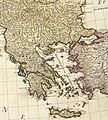Koiné language facts for kids
A koiné language (pronounced "koy-NAY") is like a special "common language" that develops when people who speak similar languages or dialects need to talk and write to each other easily. Imagine different towns in a country, each with its own way of speaking, but they all want to trade or share news. A koiné language forms by mixing parts of their different sounds, words, and grammar.
The word "koiné" comes from Ancient Greek. The most famous example is Koine Greek, which became a common way for Greeks from different city-states to communicate. It's important not to confuse koiné languages with pidgins or creoles. Pidgins and creoles are new languages that form when people who speak very different languages need to communicate, like traders from different continents. Koiné languages, however, are for people whose original ways of speaking are already quite similar.
What are some examples of Koiné languages?
Many languages we use today started as a koiné, helping people from different regions understand each other better. Here are a few examples:
- Koine Greek
- High German
- Standard Mandarin
- British English Received Pronunciation
- General American English
- Maghrebi Arabic
- Mashriqi Arabic
- Modern Standard Arabic
- Standard Japanese
- Standard Italian
- Mexican Spanish
- Peninsular Spanish
Images for kids
-
Despite their different dialects, koineization in Ancient Greece helped various Greek political groups trade and work together.
-
Koiné Greek later became the main language of the Macedonian Empire. Many people used it as a second language, and some even spoke it as their first language.
See also
 In Spanish: Lengua koiné para niños
In Spanish: Lengua koiné para niños



